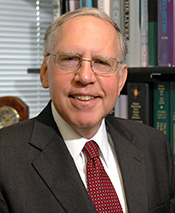

FULL STORY
Liver Disease Initiatives at the Marion Bessin Liver Research Center
Since its inception 38 years ago, Einstein's Marion Bessin Liver Research Center has taken an interdisciplinary approach to the study of liver disease. The newly installed director of the center, Allan W. Wolkoff, M.D. '72, Einstein's Herman Lopata Chair in Liver Disease Research, is continuing in that tradition as he oversees the center's 40 principal researchers from 12 academic departments—and he's reached out to experts from Montefiore, Einstein's University Hospital and academic medical center, as well.
Partnering with Montefiore

Allan W. Wolkoff, M.D. ’72, director, Marion Bessin Liver Research CenterOver the last few years, Dr. Wolkoff, a professor of medicine (gastroenterology and liver diseases) and of anatomy and structural biology, has established ties with clinical liver specialists and liver transplant surgeons at Montefiore, spurring new translational efforts. "For the first time, there's a true partnership between the medical school and the medical center in liver disease," says Dr. Wolkoff, who is also chief of the division of gastroenterology & liver diseases in the department of medicine at Einstein and Montefiore Medical Center. "This has been an extremely productive endeavor, and I intend to continue breaking down any remaining barriers between the two institutions."
Bessin center members are working in a number of disease areas:
- Liver cancer. In a collaborative project, Einstein and Montefiore researchers are searching for a blood biomarker for early detection of liver cancer—the fastest-growing form of cancer in the United States. "We have effective treatments for liver cancer, but only if it's picked up early," says Dr. Wolkoff. "If detected late, it's generally a death sentence. Right now, the only way to make sure we catch this cancer soon enough is with frequent imaging studies of at-risk patients, which can be difficult for them, not to mention costly."
- Hepatitis C and cancer. Other Einstein and Montefiore scientists are investigating whether the liver cells of hepatitis C patients with and without liver cancer have different "epigenetic" changes to their genes. These gene alterations are not mutations but instead involve molecules that contribute to the development of liver cancer by attaching to and silencing certain genes. The goal is to find patterns of epigenetic change that may help predict which hepatitis C patients will develop cancer, so that they can receive early, lifesaving treatment.
- Fatty liver disease genes. An additional joint effort is the search for genes that make people susceptible to fatty liver disease (FLD), a disorder associated with obesity. For reasons not fully understood, many patients with FLD develop cirrhosis, liver failure or liver cancer—complications particularly common among Hispanics, suggesting that a genetic component drives the more severe forms of the disease.
And among the innovations to emerge from the evolving Einstein-Montefiore partnership is a biorepository for tissue samples from liver disease patients. The repository offers a wealth of specimens for studies of liver cancer, hepatitis C and other liver diseases.

A version of this article was originally published in the Einstein 2012-2013 Annual Report
Gaining Ground
The steady rise in patients with liver disease poses a challenge to Dr. Wolkoff and his Bessin center colleagues. But he is optimistic, pointing to steady progress against hepatitis C.
"When I first started in this field, we had no test for the virus and essentially no treatment," he says. "Now, we have a blood test for the infection and new drug treatments that can achieve cure rates of up to 80 percent. And there are many new drugs on the horizon. It's an exciting time in hepatology."
Serendipity and Success
For someone who claims that "planning has not figured largely in my life," Dr. Wolkoff has come far.
He majored in abstract math in college until realizing that there "wasn't much opportunity to work in the nth dimension," as he puts it. So he turned to medicine, studying first at Dartmouth (which at the time offered only the first two years of medical school) and then at Einstein, from which he received his M.D. degree in 1972.
Dr. Wolkoff expressed interest in research while at Einstein and was referred to Irwin Arias, M.D., the renowned hepatologist who would soon become the founding director of the Bessin center.
"I had no idea who he was," Dr. Wolkoff admits. "If I'd had my druthers, I would probably have ended up in endocrinology." But it proved to be a good match. Dr. Wolkoff's very first paper, coauthored with Dr. Arias, was the lead article (on Dubin-Johnson syndrome) in the January 18, 1973, issue of the New England Journal of Medicine.
Dr. Wolkoff went on to a residency in medicine at Bronx Municipal Hospital (now Jacobi Medical Center) and returned to Einstein as an assistant professor at the tender age of 28. Math lovers will be pleased to know that Dr. Wolkoff's skill with numbers has not gone to waste. Early on, he served on the Scientific Computer Committee at Einstein, and—long before computers were ubiquitous in biomedical research—he wrote software programs for cancer researchers while on sabbatical.
"If I'd stuck with it, I could probably have been one of those computer billionaires funding medical schools instead of working for one," he says with a laugh.
However, he has made contributions of a different type: those of knowledge. During his three-plus decades at Einstein, Dr. Wolkoff, associate chair for research in the department of medicine, has studied liver cell membrane proteins, investigating how liver cells transport drugs and other molecules across their membranes and throughout the cells. In 2012 he was honored with the American Liver Foundation's Distinguished Scientific Achievement Award for his fundamental additions to the understanding of liver pathobiology.
Posted on: Thursday, August 8, 2013

Tablet Blog